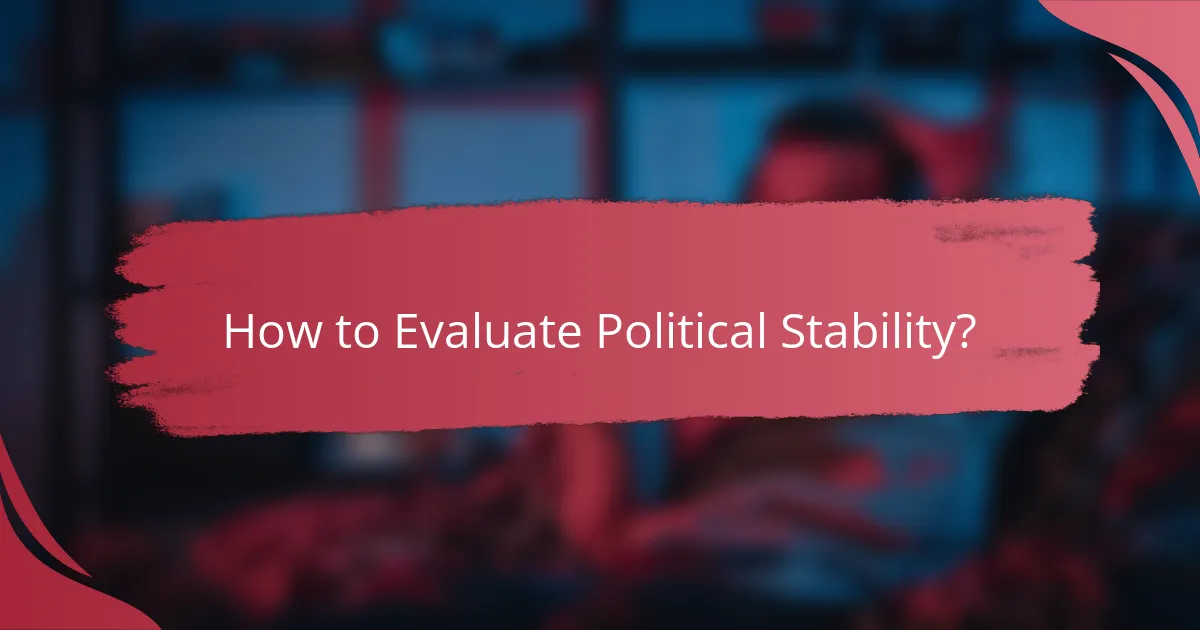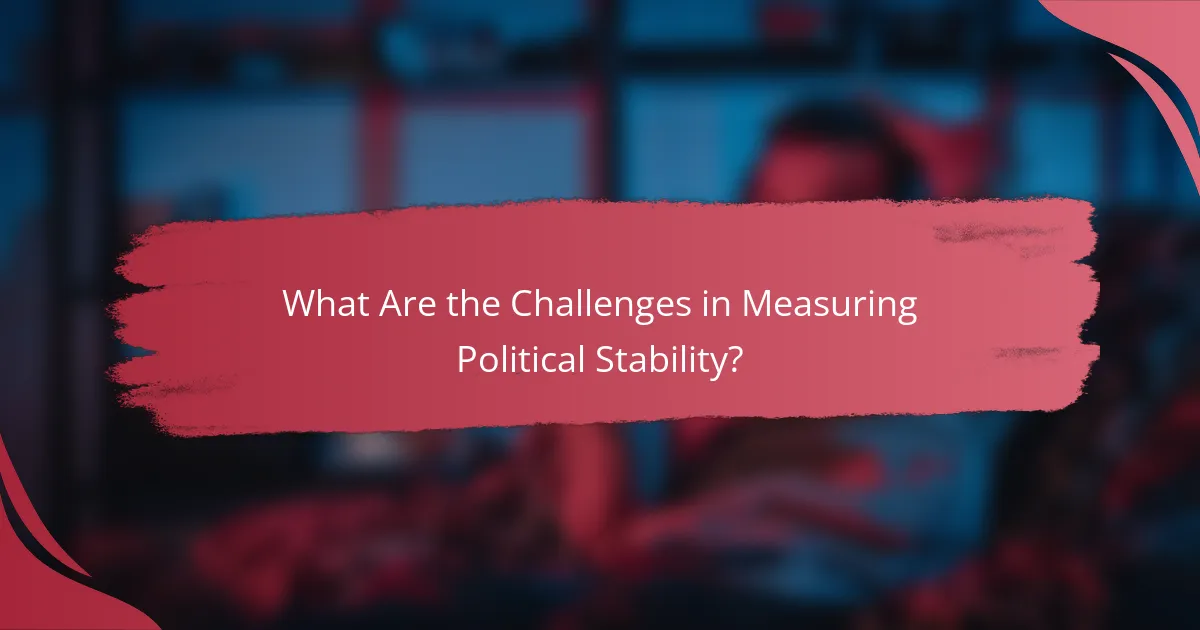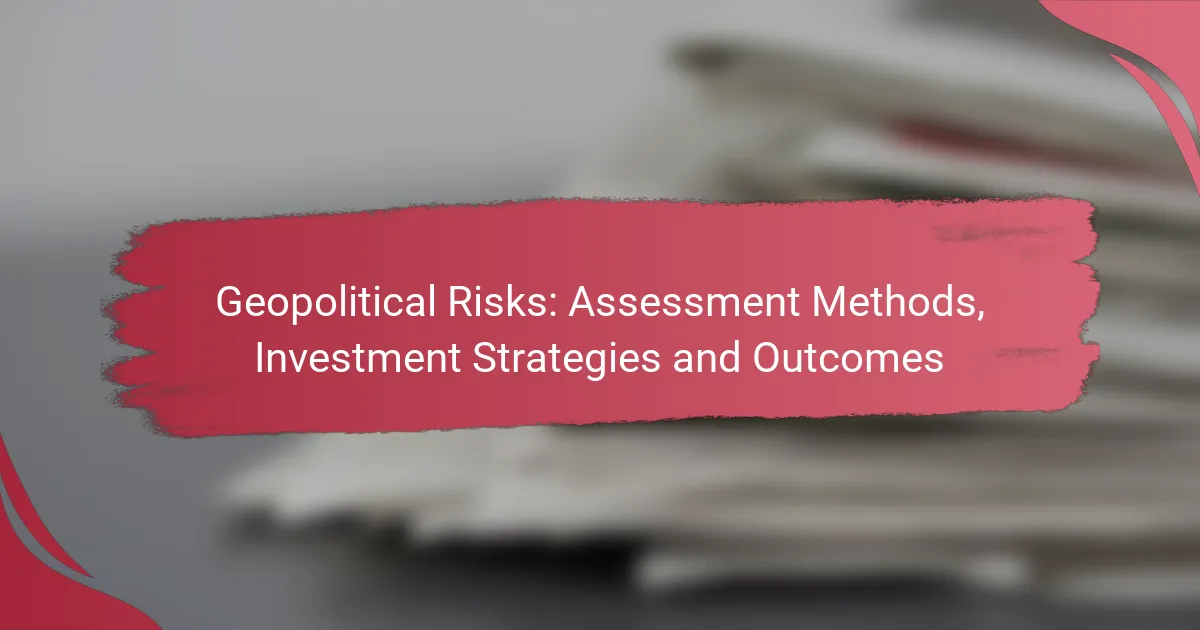Political stability metrics are crucial for evaluating the strength and effectiveness of governance within a country. By analyzing various indicators, such as voter turnout and public trust, stakeholders can identify risks and areas for enhancement, ultimately guiding informed decision-making. These evaluations employ a mix of quantitative and qualitative techniques to provide a comprehensive understanding of a political system’s resilience and functionality.

What Are the Key Political Stability Metrics?
Key political stability metrics are essential tools for assessing the robustness and reliability of a country’s governance. These metrics help identify potential risks and areas for improvement in political systems, enabling stakeholders to make informed decisions.
Government effectiveness
Government effectiveness measures the quality of public services, the capacity of the civil service, and the credibility of the government’s commitment to policies. High effectiveness indicates that a government can implement policies efficiently and respond to citizens’ needs.
To evaluate government effectiveness, consider factors such as the efficiency of public administration and the quality of regulatory frameworks. Countries with effective governments often rank higher in global indices, with scores typically ranging from 0 to 1, where higher values indicate better performance.
Political violence index
The political violence index assesses the likelihood of violent conflict, including civil wars, terrorism, and political assassinations. A high index score suggests a greater risk of instability and unrest.
When analyzing this index, look for trends over time and regional comparisons. Countries with low political violence scores often have strong conflict resolution mechanisms and inclusive political processes, while those with high scores may face significant challenges in governance and security.
Corruption perception index
The corruption perception index gauges the perceived levels of public sector corruption in a country. This index is crucial as high corruption levels can undermine political stability and public trust in government.
Scores typically range from 0 (highly corrupt) to 100 (very clean). Countries with scores above 50 are generally viewed as having lower corruption, which correlates with greater political stability. Monitoring changes in this index can provide insights into the effectiveness of anti-corruption measures.
Social unrest indicators
Social unrest indicators track events such as protests, strikes, and riots, reflecting the population’s dissatisfaction with government policies or social conditions. High levels of unrest can signal underlying political instability.
To assess social unrest, consider the frequency and scale of protests, as well as public sentiment. Countries experiencing frequent unrest may need to address grievances related to economic inequality, social justice, or political representation to restore stability.
Economic stability measures
Economic stability measures evaluate the overall health of a country’s economy, including factors like inflation rates, unemployment levels, and fiscal policies. A stable economy is often a foundation for political stability.
Key indicators include GDP growth rates, inflation (ideally low single digits), and public debt levels. Countries with stable economic conditions typically experience lower risks of political turmoil, as economic prosperity can enhance public satisfaction and trust in government.

How to Evaluate Political Stability?
Evaluating political stability involves analyzing various metrics and indicators that reflect the resilience and functionality of a political system. Key methods include quantitative analysis, qualitative assessments, and comparative studies of different countries.
Quantitative analysis methods
Quantitative analysis methods utilize numerical data to assess political stability. Common indicators include GDP growth rates, inflation rates, and levels of foreign direct investment, which can signal economic health and stability. Statistical models often incorporate these metrics to predict future political conditions.
For effective quantitative analysis, consider using indices such as the Global Peace Index or the Fragile States Index, which compile various data points into a single score. These scores can help identify trends over time and compare different nations.
Qualitative assessment techniques
Qualitative assessment techniques focus on non-numeric data to gauge political stability. These may include expert interviews, surveys of public opinion, and analysis of political discourse. Understanding the sentiments of the populace can provide insights into the underlying stability of a political system.
When employing qualitative methods, it is crucial to consider cultural and historical contexts. For example, a country with a long history of political unrest may exhibit different stability indicators compared to a nation with a stable governance tradition, even if their current economic indicators are similar.
Comparative country analysis
Comparative country analysis involves examining political stability across different nations to identify patterns and best practices. This method can highlight how various governance structures, policies, and social conditions contribute to or detract from stability.
To conduct effective comparative analysis, select countries with similar socio-economic backgrounds or political histories. This approach allows for a more accurate assessment of what factors contribute to political stability, such as legal frameworks, civil liberties, and institutional integrity.

What Indicators Reflect Political Stability Trends?
Political stability trends can be assessed through various indicators that provide insights into the health of a political system. Key metrics include voter turnout rates, political party stability, and public trust in institutions, each reflecting different aspects of governance and civic engagement.
Voter turnout rates
Voter turnout rates indicate the percentage of eligible voters who participate in elections, serving as a critical measure of political engagement. Higher turnout often correlates with greater public interest in governance and can signal a stable political environment.
For example, turnout rates above 60% are generally seen as a sign of a healthy democracy, while rates below 50% may suggest disillusionment or systemic issues. Monitoring these rates over time can reveal trends in civic participation and public sentiment.
Political party stability
Political party stability refers to the consistency and longevity of political parties within a system. Stable parties tend to provide predictable governance, which can enhance political stability by fostering trust among citizens.
In many democracies, parties that maintain a strong base and avoid frequent leadership changes are more likely to contribute to a stable political climate. For instance, parties that secure over 30% of the vote in multiple elections often indicate a solidified political landscape.
Public trust in institutions
Public trust in institutions measures citizens’ confidence in their government and its various branches. High levels of trust are essential for political stability, as they encourage compliance with laws and support for policies.
Surveys that gauge trust levels can reveal significant insights; for example, when trust exceeds 50%, it typically reflects a stable political environment. Conversely, declining trust can lead to unrest and challenges to authority, making it crucial for governments to engage transparently with the public.

What Are the Challenges in Measuring Political Stability?
Measuring political stability is complex due to various factors that can skew results and interpretations. Key challenges include data availability, subjective assessments, and the ever-changing nature of political environments.
Data availability issues
Data availability is a significant challenge in assessing political stability. Reliable data may be scarce, especially in regions with limited transparency or ongoing conflict. For instance, countries experiencing civil unrest may not provide accurate statistics on governance or public sentiment.
Additionally, historical data might be incomplete or biased, making it difficult to establish trends. Researchers often rely on proxies or indirect indicators, which can lead to misinterpretations of a country’s stability.
Subjectivity in assessments
Subjectivity plays a crucial role in evaluating political stability, as different analysts may interpret the same data differently. Factors such as personal biases, cultural perspectives, and political affiliations can influence assessments. For example, a political analyst from a democratic nation may view a regime’s stability through a different lens than someone from an authoritarian context.
To mitigate subjectivity, it’s essential to use standardized metrics and frameworks. However, even standardized assessments can be influenced by the evaluator’s perspective, leading to varying conclusions about a country’s stability.
Dynamic political environments
Political environments are inherently dynamic, with conditions changing rapidly due to events like elections, protests, or international relations. This volatility makes it challenging to maintain an accurate picture of stability over time. For instance, a country may appear stable one year but face significant unrest the next due to economic downturns or leadership changes.
To effectively measure political stability, analysts must continuously update their assessments and consider both short-term and long-term trends. This requires a flexible approach that accounts for sudden shifts while recognizing underlying patterns that may indicate future stability or instability.

How Do Regional Factors Influence Political Stability?
Regional factors play a crucial role in shaping political stability by affecting governance, social cohesion, and economic conditions. Elements such as geography, culture, and historical context can either bolster or undermine stability within a region.
Geographical Influences on Political Stability
Geography significantly impacts political stability through resource distribution, accessibility, and environmental challenges. Regions rich in natural resources may experience wealth but also conflict over those resources, while areas prone to natural disasters can face instability due to economic disruptions.
For example, countries in the Horn of Africa often deal with political unrest exacerbated by droughts and resource scarcity. In contrast, nations with favorable geography, like those in Western Europe, tend to enjoy higher stability due to better infrastructure and resource management.
Cultural and Ethnic Factors
Cultural and ethnic diversity can either enhance or challenge political stability. Regions with a strong sense of national identity and social cohesion typically experience fewer conflicts, while those with significant ethnic divisions may face tensions and violence.
For instance, countries like Canada benefit from multiculturalism and inclusive policies, which promote stability. Conversely, nations with deep-seated ethnic rivalries, such as those in the Balkans, often struggle with political fragmentation and unrest.
Economic Conditions and Stability
Economic conditions are a fundamental determinant of political stability. High unemployment rates, inflation, and poverty can lead to dissatisfaction and unrest, while stable economies foster trust in governance and institutions.
For example, countries in Scandinavia enjoy high levels of political stability due to robust welfare systems and low inequality. In contrast, nations facing economic crises, such as those in parts of Latin America, often see increased political volatility and protests.
Historical Context and Political Legacy
The historical context of a region shapes its political landscape and stability. Nations with a history of democratic governance are more likely to maintain stability compared to those with a legacy of authoritarian rule or conflict.
For instance, post-apartheid South Africa has worked towards building a stable democracy, albeit facing challenges. In contrast, countries with recent histories of civil war, like Syria, struggle significantly with political stability due to ongoing conflicts and governance issues.



